Kiev (Kyiv, Kyiv, Kiev) - the capital of Ukraine
The Organization
- Movie theaters in Kiev
- Liaison offices
- Courts of Kyiv and region
- Taxation in Kiev
- Motor shows in Kiev
- Baysseins of Kiev
- Skating rink in Kiev
- Sledge in Kiev
- Fishing in Kiev
- Bicycle routes of Kiev
- Banks of Kiev
- Zags of Kiev
- MREV ta VDAІ m. Kyiv
- Tire service in Kiev
- Service station in Kiev
- First aid of Kiev
- Pharmacies of Kiev
- Hospitals in Kiev
- ATS of Kyiv
- Pizza in Kiev
- Sushi in Kiev
- Wi-Fi points in Kiev
- Bird Market
- ZhEKi of Kiev (Housing and communal services)
- BTI Kyiv
Interesting
- Yandex Map of Kiev
- Google Map of Kiev
- Metro station of Kiev
- Bird Market Online
- Hypermarket Auchan
- Kiev train
- Auto Cameras in Kiev
- Chambers in Kiev
- History of Kiev
- Exhibitions in Kiev
- Picnic places in Kiev
- 11 lakes in Kiev
- Secret Kiev
- Interesting Kiev
- Maps of pollution in Kiev
- How to fill in new HYCOS payments
- Kiev without a guide
- Kyiv Mystic
- Meeting of the Dawn
- The Kiev murals (Scale drawings)
- What to do in Kiev
- 105 public registers of Ukraine
- Monument Motherland Mother
Services
- OVERVIEW: Chinese Food
- OVERVIEW: Pizza
- The scheme of municipal transport
- Shuttle buses
- Shuttle bus 2
- Contacts of state bodies
- Railway, Avia, Tours, Holidays
- Postal codes
- Taxi
- Telephone codes
- Calculation of the rent
- Finding Medicines
- Phones
- Timezone
- Service centers
- Fishing in the city of Kiev
- Bike Route Planner

| A country | Ukraine
|
| Status | capital |
| Coordinates |
 50 ° 27'00 "NIS 30 ° 30'00" in. Etc. / 50.45 ° N. W. 30.5 ° c. E. 50 ° 27'00 "NIS 30 ° 30'00" in. Etc. / 50.45 ° N. W. 30.5 ° c. E. |
| Internal division | 10 districts |
| City Head | Vitaliy Klichko |
| Based | VI-VII century |
| First mention | [[Con. V- beginning. VI centuries. N. E.]] |
| City from | IX century |
| Area | 870.5 Km2 |
| Highest point | 203 m |
| Population | - 2,888,470 people
|
| Density | ^ 3408 people / km2 |
| Agglomeration | Kiev agglomeration 4 071 000 |
| National composition | (According to the 2001 census) Ukrainians - 82.2%, Russians - 13.1%, Jews - 0.7%, Belarusians - 0.6%, Poles - 0.3% |
| Confessional composition | Orthodox, Protestants, Greek Catholics, Catholics, Muslims, Jews |
| Ethno-buried | Kievlyanin, kievlyanka, kyivlyane |
| Timezone | UTC + 2, in summer UTC + 3 |
| Telephone code | +380 44 |
| Postal codes | 01000 - 06999 |
| Car code | AA, KA / 11, 28, AI, KI / 10 |
| KOATUU | 8000000000 |
| Official site | Kievcity.gov.ua (ukr.)
|
| Awards | |
| Holy patron | archangel Michael |
| Unofficial titles | Mother of Russian cities, New Jerusalem |
Kiev
Kiev (Ukrainian, pronounced [kyiv]) is the capital of Ukraine, the hero city, the "mother of Russian cities".
Kiev is the capital and the largest city in Ukraine, a hero city. It is located on the Dnieper River. It is the center of the Kiev agglomeration. Kiev is a separate administrative and territorial unit of Ukraine, a cultural, political, socio-economic, transport and scientific and governmental center of the country. Kiev is also the administrative center of the Kiev region, although it is not part of it, having a special legal status (see section 5 of this article). It is located in the north of the central part of Ukraine. Kiev is the seventh most populous city in Europe after Moscow, London, Paris, St. Petersburg, Berlin and Madrid.
Kiev is located on both banks of the Dnieper, in its middle reaches, below the confluence of the left tributary - the Desna. The northern part of the city is located on the Podolsky lowland, the south-western (right-bank) - on the Dnieper Upland, the south-eastern (left-bank) - on the Dnieper Lowland.
The climate of Kiev is moderately continental, with a mild winter and a warm summer.
For its long history, Kiev was the capital of glades, Kievan Rus, Kyiv principality, Ukrainian People's Republic, Ukrainian State, Ukrainian Soviet Socialist Republic, and since 1991 - independent Ukraine.
The city has its own emblem and flag. Due to its historical significance as the center of Kievan Rus, the city is still called "Mother of Russian Cities". The length of the city from north to south is 50 km, from west to east - 56 km.
Heraldry of Kiev - Modern coat of arms of Kiev. The main element of the coat of arms of Kiev - the figure of the archangel Michael is found on the seals and coins of the Kiev princes (where he usually depicts the prince himself). One of the first preserved images of the Kiev emblem with the image of an angel holding a sword in his hand is in the Titular of 1672, the same coat of arms was also given in the arms of 1730.
Symbols of the Region - In the azure shield with a green base, St. George on a white horse in gold armor and a helmet, a purple cloak with a spear in his hands and a halo around his head. The rider is pierced by the lance of a brown snake with folded krill. The shield is decorated with two oak branches with green leaves and brown acorns, as well as six spikelets of wheat, which are placed symmetrically on three spikelets of both sides of the shield. Above the shield is a diadem that has nine segments. In the central segment of the diadem is the image of Christ the Savior with a halo. In the segments to the right of Christ the Savior is the image of St. Prince Vladimir with a halo above his head, followed by Prince Yaroslav the Wise. In the segments to the left of Christ the Savior is the image of the holy princess Olga with a halo above her head, followed by Anna Yaroslavna. In the 3 and 4 segments to the right and left of Christ the Savior is depicted a stylized ornament.
Since 1960, the city has a subway.
In 2005, Kyiv became the venue for the 50th Eurovision Song Contest.
In 2012, was one of four Ukrainian cities that hosted the European Football Championship 2012.
Name
origin of name
According to one of the legends, the name of the city comes from the name of Kia - the oldest of the three brothers, who, according to legend, are considered the founders of Kiev. This legend came to us in the chronicle of the XII century "The Tale of Bygone Years": "

There is another hypothesis of the origin of the name of the city. Kiev is so named because its first inhabitants were workers (kiyane, kiyany), who served the crossing across the Dnieper. The crossing was a wooden flooring on pillars (cues) driven into the bottom. The "Tale of Bygone Years" says:

The Chronicler justified this in the following way:

An interesting version of the origin of the name of the city is given by the Slavonic Chronicle of Helmold:
"Danes call Rus also Ostrogarden for the reason that, being located in the east, it abounds in all blessings. It is also called Junigard, because in these places the Huns first lived ... ... The main city of its Hue "
Features of transliteration of the name into other languages
In Slavic languages, the second vowel in the name of this city varies considerably, which in some cases is due to the peculiarities of adjective formation on behalf of Kiy. For example, in the Russian language the city is called Kiev, in Polish - Kijow ([? Cijuf]), in Serbian and Croatian - Kijev, etc. Because Kiev has been a part of the Russian Empire and the USSR for a long time, the city name was assimilated in non-Slavic languages through Russian: English Kiev, German Kiew, etc. After Ukraine gained independence, the authorities ordered the Ukrainian names to be used as the basis for all the names of their own when they were transmitted "by the means of the English language," despite the established traditions of this language. This touched, in particular, the English name of Kiev: as a result, the word Kyiv appeared, which, however, is unusual for English speakers and is therefore used less often than Kiev.
History
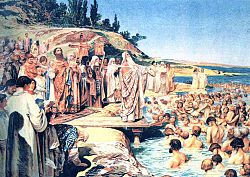

Archaeological excavations show that settlements on the territory of the Kiev region existed already 15 000-25 000 years ago. The Neolithic and Eneolithic Period (Copper Age) is represented by Trypillian culture, the monuments and periods of which the researchers divide into three stages: early (4500-3500), medium (3500-2750) and late (2750-2000 BC). For the period of the Bronze Age, the territories of the south-western part are characterized by the Belogrudov culture. Zarubinetsky culture is characteristic for the north-west of Kyiv region of the second half of the 1st millennium BC. E. - the first half of I thousand n. E.
The Iron Age in the territory of modern Kiev and the Kiev region is represented by the Chernyakhov archaeological culture, which is also called the "Kiev culture" and which existed at the turn of the II-III centuries. - the turn of the IV-V centuries. In the forest-steppe and steppe from the Lower Danube in the west to the left bank of the Dnieper and Chernigov region in the east.
There is a legend that Kiev was founded by the three brothers Kiy, Shchek and Horyv and sister Lybedyu as the center of the Polyan tribe. Named after the elder brother. The Armenian version of the Kiev legend is contained in the work of Zenob Gluck - "The History of Taron", where it is said about the foundation of Quara (Kiev) in the country of poluni (meadows) by Quar, Mentei and Herean. In the opinion of Boris Rybakov, the legend about the founding of Kiev by Kiy and his brothers in the glade land developed in the most Polanski, Slavic land, before 737. According to some archaeological research, the first urban settlement appeared in the VI century.
According to the chronicle legend, at the end of the 9th century, the virgin Vikur Rurik, the Vikings of Askold and Dir, reigned in Kiev; In 882, Kiev was conquered by a relative of Rurik, Novgorod prince Oleg, who transferred his residence there, saying: "si budi mt (i) the city of Rus'". From that moment, Kiev became the capital of a new state - so-called. Kievan Rus. Byzantine emperor Constantine Porphyrogenitus, who wrote in the middle of the 10th century, noted that Kiev had a second name - Samvatas. Probably, it was either the ancient name of the city, or its designation in a non-Slavic environment. The word, perhaps, comes from the Khazar language and in this case can mean "upper fortifications". At the eastern authors, as well as some European and Jewish writers, Kiev was called Mankerman.
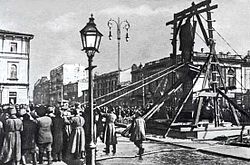
The results of some archaeological excavations are interpreted in such a way that supposedly already in the VI-VII centuries. Settlements on the right bank of the Dnieper can be considered urban. This concept, reinforced by the celebration in 1982 of the 1500th anniversary of Kiev, was viewed as generally accepted. However, some researchers indicate that the discovered archaeological sources do not give sufficient grounds for the proposed interpretation. In contrast to the "jubilee concept," some historians and archaeologists believe, as before, that the formation of Kiev as a city took place in the 8th-10th centuries. Only at the end of this period individual settlements merged into a single urban settlement.
In Kievan Rus possession of the Grand Prince of Kiev belonged (at least theoretically) to the elder in the clan and provided supreme power over the specific princes. Kiev remained the real political center of Kievan Rus, at least until the death of Vladimir Monomakh and his son Mstislav the Great (in 1132). During the fragmentation period, Kiev formally continued to be considered the senior table of Rus and served as a permanent object of the struggle between strong Russian princes. Serious blow to the city was inflicted by the defeat of the army of Vladimir Prince Andrew Bogolyubsky in 1169 and Smolensk Prince Rurik Rostislavovich in 1203. In 1240, Kiev was destroyed by the Mongol-Tatars.
Beginning in November 1917, Kiev repeatedly passed from hand to hand, the power was constantly changing:
- On November 7 (20), 1917, the Ukrainian Central Rada took power in the city.
- On January 16 (29), 1918, the January uprising of the Bolsheviks began. The uprising was suppressed on January 22 (February 4), 1918, the independence of the Ukrainian People's Republic was proclaimed - Kiev became its capital.
- On January 26 (February 8), 1918, the city was captured by the troops of Soviet Russia. Red terror, the establishment of the Soviet power in the city.
- March 1, 1918, the capture of the city by Ukrainian troops under the command of SV Petliura. Return to the city of the government of the Central Rada.
- April 29, 1918, the overthrow of the Central Rada by German troops and the proclamation by Hetman of Ukraine of P. P. Skoropadsky.
- December 14, 1918, the capture of Kiev by the troops of the Ukrainian People's Republic under the command of SV Petliura.
- February 5, 1919, the entry into Kiev of the Red Army troops.
- August 31, 1919 (morning) the entry into Kiev of the Galician army and the army of the Ukrainian People's Republic (red troops left the city on August 30);
- August 31, 1919 (the second half of the day) the entry into the city of the troops of the Volunteer Army of the Armed Forces of the South of Russia and the retreat from Kiev of Ukrainian troops.
- October 14, 1919, the capture of the city by the Red Army.
- October 16, 1919 the Volunteer Army repulsed the city.
- December 16, 1919, the capture of Kiev by the Red Army.
- On May 7, 1920, parts of the Polish Army entered Kiev.
- June 12, 1920, the capture of Kiev by the Red Army.
- From June 12, 1920 finally joined the Ukrainian SSR. In 1934, by decision of the Council of People's Commissars of Ukraine, the capital of the Ukrainian SSR was transferred from Kharkov to Kiev.
- September 19, 1941 the 37th Army of the Red Army, which defended the city, left it and began to make its way out of the encirclement. On the same day, troops of the 6th German Army entered Kiev.
- On November 5, 1943, in the morning the Wehrmacht began to withdraw troops from the city. By the morning of November 6, Kiev was liberated by the Red Army.
- In 1951, the first in the USSR and continental Europe computer MESM was created in Kiev.
- Since December 1991, Kiev is the capital of independent Ukraine.
Physico-geographical characteristics
Climate
The average annual temperature is +8.4 C °
The average annual wind speed is 2.5 m / s
The average annual humidity is 74%
The total duration of sunshine per year is 1927 hours, or 43% of the possible.
| The climate of Kiev (norm 1981-2010) | |||||||||||||
|---|---|---|---|---|---|---|---|---|---|---|---|---|---|
| Index | Jan | Feb | Mar | Apr | May | Jun | Jul | Aug | Sep | Oct | But I | Dec | Year |
| Absolute maximum, ° C | 11.1 | 17.3 | 22.4 | 30.2 | 33.6 | 35.0 | 39.4 | 39.9 | 33.8 | 27.9 | 23.2 | 14.7 | 39.9 |
| Average maximum, ° C | -0.9 | 0.0 & gt; | 5.6 | 14.0 | 20.7 | 23.5 | 25.6 | 24.9 | 19.0 | 12.5 | 4.9 | 0.0 & gt; | 12.5 |
| Average temperature, ° C | -3.5 | -3 | 1.8 | 9.3 | 15.5 | 18.5 | 20.5 | 19.7 | 14.2 | 8.4 | 1.9 | -2.3 | 8.4 |
| Average minimum, ° C | -5.8 | -5.7 | -1.4 | 5.1 | 10.8 | 14.2 | 16.1 | 15.2 | 10.2 | 4.9 | 0.0 & gt; | -4,6 | 4.9 |
| Absolute minimum, ° C | -31.1 | -32.2 | -24.9 | -10.4 | -2.4 | 2.4 | 5.8 | 3.3 | -2.9 | -17.8 | -21.9 | -thirty | -32.2 |
| Norm of precipitation, mm | 36 | 39 | 36 | 46 | 57 | 82 | 72 | 61 | 58 | 40 | 48 | 44 | 619 |
Administrative division
The city consists of 10 districts on the right and left banks of the Dnieper.
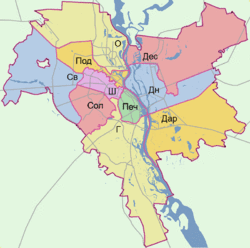 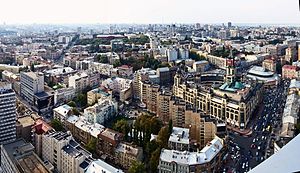
|
|
|||||||||||||||||||||||||||||||||||||||||||||||||||||||||||||||||
Approved by Kyiv Council "General plan for the development of Kiev until 2020" provides for the expansion of the capital region, which will include the districts of the Kiev region:
- Baryshevsky, Borodyansky, Brovarsky, Vasilkovsky, Vyshgorodsky, Kievo-Svyatoshinsky, Makarovsky, Fastovsky;
- A number of satellite cities, including Borispol, Boyarka, Bucha, Brovary, Vasilkov, Vishnevoye, Vyshgorod, Irpen, Fastov.
Special legal status of the city
.jpg)
According to Art. 133 of the Constitution of Ukraine the city of Kiev, as the capital of Ukraine has a special status determined by the Law of Ukraine "On the capital of Ukraine - the city-hero of Kiev" and does not obey the regional leadership (Sevastopol enjoys the same rights in Ukraine). According to the specified Law and its interpretation by the Constitutional Court of Ukraine, the head of the Kyiv city state administration (KCSA) automatically becomes the Kyiv mayor elected in direct elections by reaching the largest number of votes cast by the voters' mayor who participated in the elections.
Authorities
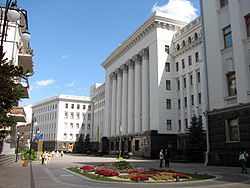
- 43 deputies from Bloc Chernovetsky,
- 32 from the Bloc of Yulia Tymoshenko,
- 15 - from the Klitschko Bloc,
- 11 - from the People's Bloc of Lytvyn,
- 8 - from the Civil Asset of Kiev,
- 6 - from the Party of Regions,
- 5 - from the Block of Nikolay Katerinchuk.
In 2010, the functions of the mayor and chairman of the Kyiv city state administration were divided. Kyiv city head was Leonid Chernovetsky, and, by the decree of the President of Ukraine, the head of KCSA was appointed by Alexander Popov. The deputies were Ruslan Kramarenko, Alexander Puzanov, Alexander Meshcheryakov, Alexander Mazurchak, Anatoly Golubchenko, Leonid Novohatko, Viktor Sivets.
June 3, 2012 the acting city mayor of Kiev was the secretary of the Kiev City Council Galina Fedorovna Gerega.
Population
.jpg)
National composition
According to the results of the general census of the population of Kiev, conducted in late 1917, Russians in Kiev lived 54.7% of the total population; Jews - 19.0%; Of Ukrainians - 12.2%. In total, representatives of 68 nationalities lived in Kiev.
At the beginning of the 21st century, the proportion of Ukrainians in Kiev increased as a nationality from 72.5% in 1989 to 82.2% in 2001. At the same time, the number of other nationalities decreased. Most of all, the Russian diaspora decreased from 536.2 thousand people (20.9%) in 1989 to 337.3 thousand people (13.1%) in 2001. The number of Belarusians also decreased (1989 - 25,3 thousand people, 2001 - 16,5 thousand people) and Poles (1989 - 10,4 thousand people, 2001 - 6,9 thousand people). By the beginning of the 21st century, the process of emigration of Jews was over (from 1989 to 2001, the absolute number of Jews in Kiev decreased from 100.6 to 17.9 thousand people, and their share in the population of the city decreased from 13.9% in 1959 to 0.7 % In 2001).
According to the 2001 census, the city's population by 82.2% consisted of Ukrainians and 13.1% of Russians. In a survey conducted in November 2006, 83% of the city's residents called themselves Ukrainians, 14% Russians, 3% Jews, Armenians and representatives of other nationalities.
Language situation
The language history of Kiev is complex and contradictory. In many respects it is a reflection of his long and rather contradictory history, as well as various changes in the language policy of the last centuries. Thus, commenting on the results of the first population census of 2001, the magazine Demoscope called Kiev "more Ukrainian-speaking (at least, wishing to seem so)." According to the latest census of 2001, 72.1% of Kyivans called their native language Ukrainian, 25.3% - Russian. This ratio has changed dramatically since the last Soviet 1989 census. At the same time, according to the majority of opinion polls, the predominant language of everyday communication is more than half the population of the city is Russian. Only 12-18% of citizens use mainly or exclusively Ukrainian. At the same time, Russian-Ukrainian bilingualism is also widespread. About a third of respondents use both languages equally. Intensive mixing of two closely related languages, leading to the appearance of the so-called surzhik, was noted in Kiev from the second quarter of the nineteenth century.
Religion
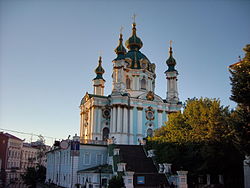
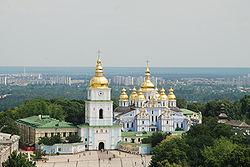
As of July 1, 2009, 1067 religious organizations are officially registered and operate in Kiev. Among them: 813 religious communities, 44 spiritual centers, 21 government, 106 missions, 21 brotherhoods, 41 religious educational institutions and 21 monasteries.
In a poll conducted in November 2006, 64% of Kiev residents called themselves believers, 9% identified themselves as believers in supernatural forces, 19% did not identify their religious affiliation, 8% - atheists. Regularly attend religious services and institutions 11% of all respondents, 64% - occasionally. In various superstitions believe from 23% (fortune telling and prediction) to 52% (talismans).
Temples
In Kiev, the first stone church of Kievan Rus was built - the Tithe Church. The most famous Kiev churches are the St. Sophia Cathedral and the churches of the Kiev-Pechersk Lavra, included in the UNESCO World Heritage List, as well as the St. Michael and Vladimir Cathedrals, St. Andrew's Church, Vydubitsky Monastery, and the Florovsky Monastery. In Kiev there are 7 synagogues.
Since 2004, the territory around the "Ar-Rahma" mosque has been expanded to build an entire Islamic complex. In 2009, the construction of the first minaret was started in Kiev.
Education
Starting from the 9th century Kyiv was an important center for the intellectual development of Eastern Europe. Since the end of the XVII century, the Kiev-Mohyla Academy has prepared many famous scientists. However, the first modern university of European design was founded by decree of Nicholas I in 1834, as the Kiev Imperial University of St. Vladimir. Kiev University became the seventh university in the Russian Empire. And today Kiev is one of the largest centers of science and education in Ukraine. In Kiev, there is a large number of higher and secondary special educational institutions, including several universities of international importance, in particular, the three most prestigious universities of Ukraine: Kyiv National Taras Shevchenko University, the NationalIn Kiev, about 350 schools, more than 100 gymnasiums and lyceums, about 70 universities, including:
- Kyiv National Economic University
- National Transport University
- National Aviation University
- Kyiv National University of Construction and Architecture (KISI)
- National Pedagogical University. M.P. Dragomanova
- State University of Information and Communication Technologies
- National University "Kyiv-Mohyla Academy"
- Kyiv Conservatory
- Institute of Advertising
- Kyiv National Linguistic University (INZYA)
- National Academy of Sciences of Ukraine (NASU)
- National University of Bioresources and Nature Management of Ukraine
- Kyiv National University of Internal Affairs
- Kyiv Art Academy
- OO Bogomolets National Medical University
- International Solomon University
- National University of Physical Education and Sports of Ukraine (INFIZ)
- Kiev National University of Theater, Film and Television named after IK Karpenko-Kary
- Kyiv National University of Culture and Arts
- Kyiv National University of Technology and Design
- National University of Food Technologies
- Kyiv University of Market Relations
- Kyiv National University of Trade and Economics
- Kiev University named after Boris Grinchenko
Industry
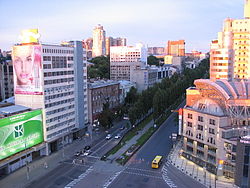
The main enterprises:
- Beer factory "Obolon"
- Kyiv Ship Repair and Construction Plant
- Kiev Jewelry Factory
- Kiev Vitamin Plant
- Pharmacological enterprise "Darnitsa"
- ANTK them. Antonova
- Kiev Mechanical Plant
- Kiev factory of sparkling wines "Stolichny"
- New buildings in Kiev
- Kiev plant of automation
- Kiev factory "Bolshevik"
- Kiev plant "Lenin's Smithy"
- Kyivkhimvolokno OJSC
- Kiev factory of special equipment
- CJSC Rostok
- Kiev plant of building materials
- State Enterprise "Burevestnik"
- OOO PTK "Agromat"
- Otis CJSC (Kiev elevator plant)
- 410 Civil Aviation Plant
- Kiev state mechanical plant
- Kiev Mechanical Repair Plant
- Kiev Aviation Plant "Aviant"
Economic indicators
 |
|
Based on the materials of the Committee of Statistics of Ukraine.
Transport
_(2681490105).jpg)
Air
There are three airports in Kiev:
- The international airport "Borispol" (located south-east of Kiev, in the city of Borispol in the Kiev region)
- International airport "Kiev" (Zhulyany)
- Gostomel Airport (Antonov Cargo Airport)
In the city there is also an experimental airfield Svyatoshin (test airfield of the Kiev aviation plant Aviant). In the vicinity of the city are also located military airfields in the cities of Vasilkov, Uzin, Belaya Tserkov. Plans for the use of Vasilkov and Belaya Tserkov airfields as passenger airports have been repeatedly discussed. Near the city there are a number of small airfields: Chaika (former DOSAAF base, parachute base, sports aviation), Buzovaya (glider base), Valley (sports aviation), Nalivaikivka (sports aviation), Byshev, Borodyanka (parachute base), Kiev-South (Buckets, agricultural aviation, parachute base, helicopters), etc.

Railway
Kiev is a major railway junction. In Kiev is the main department of the South-Western Railway. The central railway station is Kiev-Passazhirsky. In Kiev, the five main lines converge in the directions of Fastov, Korostenya, Nezhin, Grebenki, Mironovka. Also in Kiev is the "Northern Ring", which runs from the station. Borshchagovka and Art. Svyatoshin through the station. Kiev-Petrovka and Kiev-Dneprovsky to the station. Darnitsa. All main lines are electrified. There is a departmental non-electrified railway branch from the station. Kiev-Petrovka to Vyshgorod. Several commuter diesel trains run a few times a day.
In 2009, the first line of the city electric train was launched, from October 4, 2011 the trains run along the entire length of the city ring, with transfers to all metro lines.
Railway stations:
- Kiev-Passenger
- South Railway Station
- Suburban Railway Station
- Karavaevy Dachi (suburban)
- Darnitskiy railway station
- Kiev-Moscow
According to the plans of the Railways and Ukrzaliznytsia, the launch of a high-speed train with the Moscow-Kiev message is scheduled for 2015. The maximum speed of the train will be 250 kilometers per hour, and the travel time between the two capitals will not exceed 4 hours.

River
The Kiev river port was built in July 1897. The berths of the port stretch from the harbor to the metro station "Dnepr". The passenger company "Ukrrechflot" carried cargo and passenger transportation along the Dnieper. In the Soviet era, passenger transportation was unprofitable, but subsidized by the state. After the privatization of Ukrrechflot on November 11, 1992, the volume of traffic began to fall, while passenger ships and ships were sold abroad, went to scrap. Today, on the Dnieper, passengers are provided with sightseeing routes only in the vicinity of Kiev. In 2009, a type of public transport, a so-called "river tram", forgotten for Kiev, was launched for communication between the right and left banks of Kiev. The tram runs only in the warm season. Dnepr is used for transportation of bulky goods.
Metro
The construction of the metro in Kiev was started in 1949, the first site was opened on November 6, 1960. Today there are three lines (Svyatoshinsko-Brovarskaya, Kurenivsko-Krasnoarmeiskaya, Syretsko-Pecherskaya) with a total length of 65.18 km with 50 stations. Every day the metro carries around 1.422 million passengers (in 2011). The metro stations of the first stage are monuments of architecture.
A bridge is being built across the river. Dnepr on the future fourth line - Podolsko-Vigurovskaya, the fifth is planned - Vyshgorod-Darnitskaya line. In 2010-2011 four stations were opened on the Kurenivsko-Krasnoarmeyskaya line - Demievskaya, Goloseevskaya and Vasilkovskaya and Exhibition Center. The construction of the Kurenivsko-Krasnoarmeiskaya line continues towards Teremkov.
Tram
Kiev - the first city of the Russian Empire, in which there was an electric tram. The first line of 1.5 km in length was opened on June 1 (13), 1892, along the Alexandrovsky Descent (now Vladimirsky Descent) and Aleksandrovskaya Street (Sagaidachny Street). In 1978, in Kiev, the first in the USSR line of high-speed tram from Victory Square to the residential area of Borshchagovka was opened.
1990 was the culmination in the development of the tram network - the total length of the lines was 275.9 km, the production base was 904 passenger trams, the annual volume of transport reached 438 million people. Since the mid-1990s, the tram economy has gradually declined, for 2005, the corresponding figures have decreased to 258.3 km and 509 tram cars, the annual volume of traffic was about 175.6 million. After the reconstruction of the Paton Bridge in 2004, the city's tram network was torn On two separate parts - left-bank and right-bank.
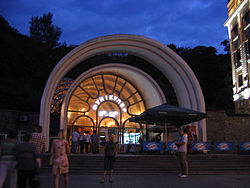
Funicular
The funicular was built as an effective way to cut the way from Upper Town to Podol. It was put into operation in May 1905. The length of its path was 193 m. It was reconstructed in 1928 (extended by 38 m), 1958 and 1984.
Trolleybus
Works on the organization of trolleybus traffic in Kiev were started in 1934 with the return to Kiev of the status of the capital. The first trolleybus line was the street. Krasnoarmeyskaya (Chervonoarmiyska - Ukr.).
The rolling stock is mainly represented by the Skoda 14Tr, K12, UMZ, ElectroLAZ-12, ElectroLAZ-20, MAZ-103T and Bogdan cars.
For 2000, 35 trolleybus routes operate in Kiev. The total length of trolleybus lines is 324.9 km, the park consists of 640 cars. Since May 2006, the number of trolleybus routes has reached 44. As of December 2010, there are 37 routes operating. There are 4 trolleybus depots.
Bus
For the first time, the regular bus traffic in Kiev was tried in 1913. In fact, the full work of the bus began in 1925. Then on a single route there were 2 buses. Now in Kiev there are about 90 municipal bus routes. The number of buses exceeds 700 units. There are 8 bus parks.
Shuttle bus
In parallel to the majority of lines of municipal transport, lines of a fixed-route taxi operate in Kiev. Also, lines of fixed-route taxis connect the city with the suburbs. The shuttle service lines are served by private trucking companies and municipal ATPs.
Residential areas and other areas
 |
|
Streets
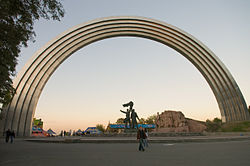 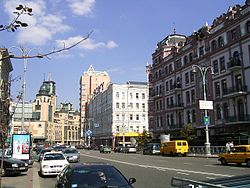 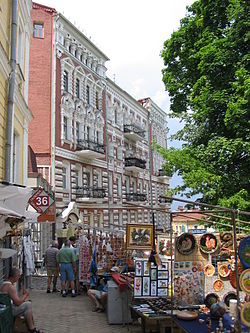
|
|
Ecology
Kiev has a reputation as one of the most green and clean capitals. Nevertheless, in recent years, in Kiev, as in all major cities, more and more important is the pollution of the air with the exhaust gases of cars. The main polluter of air in Kiev is road transport: it gives 83.4% of all harmful emissions to the atmosphere.
Culture and recreation
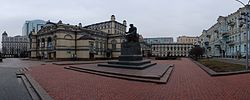

In Kiev there are 27 museums, 25 theaters and theatrical studios (for example, the National Academic Theater of Opera and Ballet of Ukraine named after T. Shevchenko, the Kiev Municipal Academic Theater of Opera and Ballet for Children and Youth, the National Academic Drama Theater named after I.Franko, the National Academic Drama Theater Theater of Podol, Kiev National Academic Theater of Operetta, Kiev State Academic Puppet Theater, Kiev Municipal Academic Puppet Theater, Kiev State Academic Drama and Comedy Theater on the Left Bank, Kiev Variety Theater, Theater "Silver Island").
In Kiev, there is one of the largest planetariums on the territory of the CIS.
Kiev is rich in monuments of culture and art. The most important of them are: the Golden Gate, St. Sophia Cathedral (11th c.), Vydubitsky Monastery (11th c.), Complex of buildings of the Kiev-Pechersk Lavra (11th-18th centuries), St. Michael's Golden-Domed Monastery, Florovsky Monastery (early 16th c. ), The Church of the Savior on Berest (XII century), the Baroque Resurrection, St. Andrew's, the Intercession, Trinity Church, painted by Victor Vasnetsov, Mikhail Nesterov, etc. Vladimir Cathedral (XIX century.) Restored / painted by Michael Vrubel. Cyril Church (XII century. ), Klovski and Mariinsky palaces.
Forests, parks and gardens make up more than half of its area. Within the city there are two botanical gardens.
Kiev is rightly called one of the most green cities in the world (and once it was considered the greenest). Famous Kiev chestnuts, which blossom luxuriantly in May, and sometimes twice a year: in spring and autumn, have become one of the symbols of the city.
Large Movie Centers
- Leipzig
- «Zhovten»
- "Kiev"
- "Ukraine"
- "Kievan Rus"
- "Butterfly"
- "The Line of Cinema"
- Multiplex
- "Oscar"
- "Odessa-cinema"
- "Zoryaniy"
- "Florence"
- "Leningrad"
- "Russia"
- «IMAX»
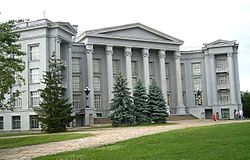
Architectural monuments
- Kiev Opera House (1867) - the architect IV Strom.
- The Old Stock Exchange (1873)
- Central Museum of the Armed Forces of Ukraine (1931) - architect I. Yu. Karakis
- St. Vladimir's Cathedral - the architect IV Shtrom.
- National Historical Museum of Ukraine (1939) - architect I. Yu. Karakis
- National Bank of Ukraine (1902-1905) - architects Alexander Kobelev and Alexander Verbitsky
- "House with chimeras" - architect V. V. Gorodetsky
- Administration of the President of Ukraine
- National Academic Drama Theater. Ivan Franco
- Children's preschool institution No. 1, the so-called "Palace of Children's Happiness" (1939) - I. Yu. Karakis
In Kiev there are also the highest latticework and the deepest metro station in the world.
 St. Michael's Cathedral |
 Golden Gate |
 The Great Bell Tower of the Kiev-Pechersk Lavra |
 Trinity Gate Church of the Kiev-Pechersk Lavra |
 Sophia Cathedral |
 House with Chimeras |
Football clubs
- Arsenal
- Dynamo
- Obolon
Great Kiev princes
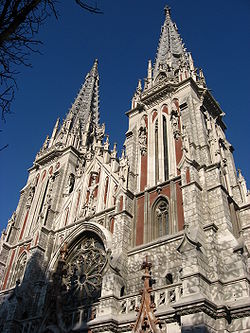  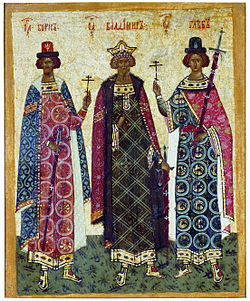
|
|
From 1254 to 1320, the title of Grand Duke of Kiev was nominally used by the Russian Kings, the descendants of Daniil Romanovich Galitsky, before the suppression of the male line, which, however, despite repeated attempts, failed to drive out the Tatar-Mongols. Thus the city remained practically deserted - the papal legate J. de Plano Carpini, driving Kiev on the way to the Saray, noted the presence of the Mongolian tumen (10 thousand horsemen) on the outskirts and not more than a thousand "residents in the most brutal slavery of the Mongols" residents on the ruins The city itself
D 1320 Galician throne took the nephew of the last King of Russia, Andrei Yurievich on the maternal line, the Mazovian prince from the Piast dynasty Boleslav (in Orthodox baptism Yuri) Troydenovich. On his relationship with both the boyars and the nobility of the land, the eloquence in the titulature and the kingdom of the Russian and Grand Duchy of Kiev is quite eloquent. In the same year the Kievites, taking advantage of the apparent weakening after the death of the Nogda Horde pressure, swore allegiance to the Grand Duke of Lithuania Gediminu
Crime
In 2011, the number of crimes increased by 3.8% compared to 2010. [45]. In general, the crime rate is higher than in Europe, but lower than in Moscow and St. Petersburg.
Mayors of Kiev
For the first time the mayor was elected in 1835.
Printed editions
Popular printed editions of Kiev, the newspaper: "Facts and Comments", "Today", "Komsomolskaya Pravda" in Ukraine, "Telenedelya".
Leading editions in the sphere of education: "Suhasna osvita", "Work and Studies".
In Kiev, more than 40 different newspapers and magazines are printed. The biggest circulation is in the advertising and information newspapers "Rio" (circulation 1 100 000 copies), "Kiev on Doloni" (circulation 1 050 000 copies), "Misto +" (circulation 908 178 copies).
Children's publications: the newspaper Kazkiviy Vechir (Ukrainian), magazines Barvynok (Ukr.), Malyatko (Ukr.), Professor Kreid, Poznayka.
Famous natives
- Alexander Arkhipenko is a Ukrainian and American artist and sculptor, one of the founders of Cubism in sculpture.
- Mikhail Bulgakov is a Russian writer, the author of the novel "Master and Margarita".
- Artemije Wedel - composer and singer (tenor) of the XVIII century, the author of many-voiced church music.
- Alexander Vertinsky is a Russian entertainer, film actor, composer, poet and singer.
- Xenia Derzhinskaya - Russian Soviet opera singer (soprano). People's Artist of the USSR.
- Boris Efimov - Soviet graphic artist, political cartoonist.
- Milla (Milica) Jovovich is an American actress of Slavic origin.
- Serge (Sergey) Lifar is one of the famous dancers of the XX century. He performed in France and in many other countries.
- Valery Lobanovsky is a Soviet and Ukrainian football player and football coach.
- Kazimir Malevich is an avant-garde artist, the founder of Suprematism. The author of the famous "Black Square".
- Golda Meir (Mabovich) - Israeli political and statesman, former. head of the government.
- Viktor Nekrasov is a Soviet and Russian writer, the author of a number of works that were subjected to sharp political condemnation by the Soviet authorities.
- Vaclav Nijinsky is a Russian dancer and choreographer of Polish descent.
- Boris Paton - Academician, President of the Academy of Sciences of Ukraine.
- Igor Sikorsky is a Russian-American aircraft designer, one of the largest figures in the history of aircraft construction. The creator of the modern helicopter.
Rulers buried in Kyiv
- Alexander Arkhipenko is a Ukrainian and American artist and sculptor, one of the founders of Cubism in sculpture.
- Mikhail Bulgakov is a Russian writer, the author of the novel "Master and Margarita".
- Artemije Wedel - composer and singer (tenor) of the XVIII century, the author of many-voiced church music.
- Alexander Vertinsky is a Russian entertainer, film actor, composer, poet and singer.
- Xenia Derzhinskaya - Russian Soviet opera singer (soprano). People's Artist of the USSR.
- Boris Efimov - Soviet graphic artist, political cartoonist.
- Milla (Milica) Jovovich is an American actress of Slavic origin.
- Serge (Sergey) Lifar is one of the famous dancers of the XX century. He performed in France and in many other countries.
- Valery Lobanovsky is a Soviet and Ukrainian football player and football coach.
- Kazimir Malevich is an avant-garde artist, the founder of Suprematism. The author of the famous "Black Square".
- Golda Meir (Mabovich) - Israeli political and statesman, former. head of the government.
- Viktor Nekrasov is a Soviet and Russian writer, the author of a number of works that were subjected to sharp political condemnation by the Soviet authorities.
- Vaclav Nijinsky is a Russian dancer and choreographer of Polish descent.
- Boris Paton - Academician, President of the Academy of Sciences of Ukraine.
- Igor Sikorsky is a Russian-American aircraft designer, one of the largest figures in the history of aircraft construction. The creator of the modern helicopter.
- [Edit] Rulers buried in Kiev
- Balthasar, the ruler of the White Huns - one of the Kiev hills ("Kijaw-uruss")
- Askold, Prince of Kiev - Askold's grave
- Dir, Prince of Kiev - behind the church of St. Irina
- Oleg the Prophet, Prince of Novgorod and Grand Duke of Kiev - Schekavitsa
- Olga, Princess of Kiev - Tithe Church
- Yaropolk Svyatoslavich, Grand Duke of Kiev - Tithe Church
- Oleg Svyatoslavich, Prince of Drevlyansky - Tithe Church
- Vladimir Svyatoslavich, Grand Duke of Kiev - Tithe Church
- Yaroslav Vladimirovich Wise, Grand Duke of Kiev - St. Sophia Cathedral
- Izyaslav Yaroslavich, Grand Duke of Kiev - St. Sophia Cathedral
- Yaropolk Izyaslavich, Prince of Volyn and Turov, titular king of Rus - Dmitrovsky monastery
- Vsevolod Yaroslavich, Grand Duke of Kiev - St. Sophia Cathedral
- Svyatopolk Izyaslavich, Grand Duke of Kiev - St. Michael's Golden-Domed Monastery
- Gleb Vseslavich, Prince of Minsk - Assumption Cathedral of the Kiev-Pechersk Lavra
- Vladimir Vsevolodovich Monomakh, Grand Duke of Kiev - St. Sophia Cathedral
- Yaropolk Vladimirovich, Grand Duke of Kiev - Yanchin Monastery
- Mstislav Vladimirovich the Great, Grand Duke of Kiev - Fyodorovsky Monastery
- Nikolay Svyatosha, Prince Lutsky - Near caves of the Kiev-Pechersk Lavra
- Yuri Dolgoruky, Prince of Rostov-Suzdal and Grand Duke of Kiev - Church of Our Savior on Berestov
- Rostislav Mstislavich, Prince of Smolensk and Grand Duke of Kiev - Fyodorovsky Monastery
- Vladimir Andreevich, Prince Dorogobuzhsky - Yanchin Monastery
- Svyatoslav Vsevolodovich, Prince of Chernigov and Grand Duke of Kiev - St. Cyril's Church
- Gleb Yuryevich, Prince of Turov - St. Michael's Golden-Domed Monastery
- Vsevolod Svyatoslavich Cherny, Prince of Chernigov and Grand Duke of Kiev - St. Cyril's Church
- Mstislav Mstislavich Udatny, Prince of Galich - Cross Exaltation Church
- Skigailo, Prince of Kiev and Polotsky, governor of Jagailo in the Grand Duchy of Lithuania - Kiev Pechersk Lavra
- Vladimir Olgerdovich, Prince of Kiev - Assumption Cathedral of the Kiev-Pechersk Lavra
- Fedor Danilovich, Prince Ostrozhsky - The distant caves of the Kiev-Pechersk Lavra
- Olelko Vladimirovich, Prince of Kiev - Assumption Cathedral of the Kiev-Pechersk Lavra
- Semen Olelkovich, Prince of Kiev - Assumption Cathedral of the Kiev-Pechersk Lavra
- Peter Konashevich-Sagaidachny, the ataman of Zaporizhzhya Sich and the hetman of the Army of Zaporozhye - the Kiev-Brotherly Epiphany Monastery
- Pyotr Stolypin, Chairman of the Council of Ministers of the Russian Empire - Kiev Pechersk Lavra
- Mikhail Sergeevich Hrushevsky, Chairman of the Central Rada of the Ukrainian People's Republic - Baikovo Cemetery
- Yuri Kosmich Glushko-Mova, head of the Ukrainian Far Eastern Secretariat - Lukyanovskoe cemetery
- Pavlo Grigorievich Tychina, Chairman of the Supreme Soviet of the USSR - Baykovo Cemetery
- Demyan S. Korotchenko, Chairman of the Presidium of the Supreme Soviet of the USSR - Baykovo Cemetery
- Alexander Evdokimovich Korneichuk, Chairman of the Supreme Soviet of the USSR - Baykovo Cemetery
- Mikhail Sergeyevich Grechukha, Chairman of the Presidium of the Supreme Soviet of the USSR - Baykovo Cemetery
- Ivan Samoylovich Grushetsky, Chairman of the Presidium of the Supreme Soviet of the USSR - Baykovo Cemetery
- Alexey Fedoseevich Vatchenko, Chairman of the Presidium of the Supreme Soviet of the Ukrainian SSR - Baikovo Cemetery
- Mikhail Ulyanovich Bely, Chairman of the Supreme Soviet of the USSR - Baykovo Cemetery
- Alexander Pavlovich Lyashko, Chairman of the Presidium of the Supreme Soviet of the USSR - Baykovo Cemetery
- Platon Grigoryevich Kostyuk, Chairman of the Supreme Soviet of the USSR - Baykovo Cemetery
Topographical maps
Sheet of the map M-36-XIII Kiev. Scale: 1: 200,000. The state of the area for 1985. The 1986 edition

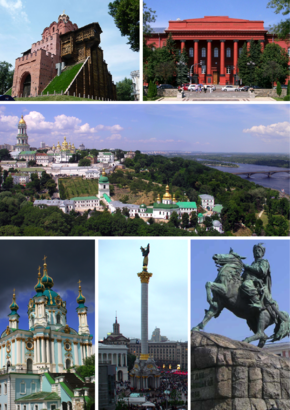
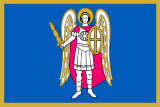

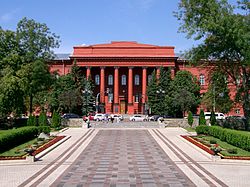

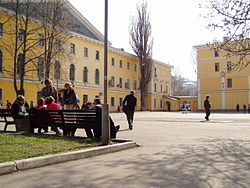


Comments
When commenting on, remember that the content and tone of your message can hurt the feelings of real people, show respect and tolerance to your interlocutors even if you do not share their opinion, your behavior in the conditions of freedom of expression and anonymity provided by the Internet, changes Not only virtual, but also the real world. All comments are hidden from the index, spam is controlled.